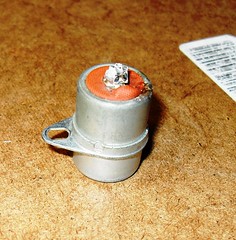the OP said:
Alec, thanks for that spec on the trimpot. I've never seen specs for the magneto coil. Is there a way for me to measure it on my bike, to improve the simulation?
The OP has a short attention span, probably like we all do. There is too much stuff here.
https://www.banggood.com/DIY-Meter-...ntent=vera&emst=2NKh40Be80_237878_1013964_129
(almost free), or a cheap LCR meter, I brought up earlier. There is a recent discussion on ETO. F
or <$15.00 USD you can't not have one in your junk box. It;s a Chinese clone. Design data is available on the web and it can be improved. Nigel on ETO has one.
See:
https://www.electro-tech-online.com/threads/nice-little-component-tester-kit.141912/
I updated the link. It was wrong.
With a circuit based to the LT3092 and a DVM, we could measure low resistance.
https://www.google.com/url?sa=t&rct=j&q=&esrc=s&source=web&cd=1&cad=rja&uact=8&ved=0CCAQFjAA&url=https://www.linear.com/product/LT3092&ei=qak-VLjSBtHksATrmoGwCQ&usg=AFQjCNFJ7mg1SlKE9r1oeqRSGZe_gNxYpQ&sig2=lyK0PPwlgA8b7GkDCiqpSQ&bvm=bv.77412846,d.cWc
e.g. set for 50 mA and a small battery. You measure the current through the device and the voltage across the device. The banggood device claims 0.5 ohms minimum.
I measured the Cap with a portable Agilent/Keysight meter which supports multiple frequencies and is about $500 USD. alec used my data from a pump that was mailed to me for an aquarium pump controller. That thread went for more than a year. PS: I heard from Joe. No water in the tank yet. ()b is doing good things. No time for ETO.
alec: Mouser and National Instrument just introduced Multisimblue. See under reviews.
alect_t said:
For the situation of a blown brake bulb, although some current flows through the reg it is doubtful if there would be enough spark voltage below ~3000 rpm to keep the engine running.
While it could be true, apparently the only way to keep bulbs from blowing is to regulate or increase the power of the magneto. The OEM regulators that were developed shunt excess to the frame. i.e.shunt regulators.
The points pitting in 4 hours seems like a capacitor problem. Regulation could prolong bulb life, but won't keep the bike running unless alec can come up with some more magic. e.g. Hall effect current sensors in series with the bulb and in series with the regulator to somehow switch in a fixed resistor or FET. Brainstorming!
EDIT: Updated component tester link - wrong one. The one in question is a kit. So, the earlier link is wrong.



